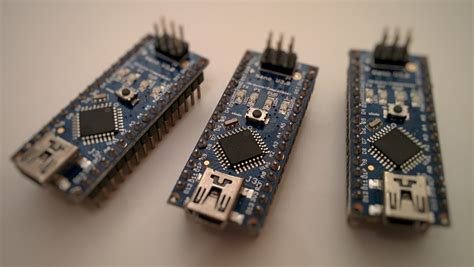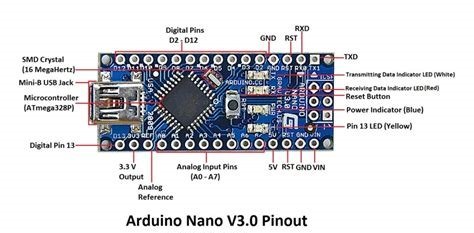Arduino Nano Review
Hello friends, the Arduino Nano is the cheapest Arduino you can buy, but is it worth it? Let's take a look at the pros and cons of this little board.

While there are many Arduino boards to choose from, the Nano is a versatile board that can be used for almost any electronics DIY project. These tiny microcontrollers are enabling compact DIY hardware development for more people than ever before.
Advantages
- Great platform for beginners.
- Small size
- Functionally identical to its larger counterpart.
- Fits on a breadboard to make prototyping easier.
The lack of local connectivity limits Internet of Things (IoT) usage and limited onboard memory can complicate complex programs.
Aside from its smaller size, the main difference is the USB port, and the Nano connects to your computer via a micro USB cable. It's the perfect microcontroller for learning hobby electronics and programming, and its size makes it ideal for inclusion in projects that require a small form factor.
A real Arduino Nano costs $21, which is cheaper than the Uno.
All Arduino Nano boards now come with an ATmega328p chip, which means that the Nano's maximum input voltage is slightly lower than previous models.
One of the strengths of Arduino in general is the huge community behind it. Whatever you decide to do, there's a chance someone else will try it first. There are countless blogs and forum posts covering everything a beginner can think of. Whether you need help with coding or tips on creating the correct electronic circuit for your build, Arduino users around the world are here to help and advise you.
The official Arduino website contains a quick guide for getting started with the Nano, and the board can be programmed directly from the browser using the Arduino web editor.
The Arduino Nano seems to have a small but significant advantage over other larger Arduino boards. Because it doesn't have the irregular pin spacing of the original Arduino design, it fits on a breadboard.

This has obvious advantages. Whether you're just getting started with DIY hobby electronics, being able to work this way allows for quick creative prototyping without soldering or fixing designs.
We've seen how great an Arduino Nano can be, but for some, price is still an issue. Those on a tight budget might consider cloning boards. The official Nano costs $21, while its clone is more than 10 times cheaper, at $1.80 on AliExpress.
These clone boards are functionally identical to the official Arduino boards. If you have interest in use the official Arduino brand, it makes perfect sense to buy directly from them. If you don't mind, cloning looks like a piece of cake.
Since they are based on the freely available Arduino reference design, they are generally functionally identical. If the board looks almost identical and the workflow is the same, why not clone it?
One omission from the Nano, as well as most Arduino branded boards, is connectivity. The Nano has no built-in Wi-Fi or Bluetooth capabilities. This may be a limiting factor as the smart home and Internet of Things (IoT) market continues to grow and its huge popularity in the DIY space.
The Arduino Nano it's programmed to perform simple tasks that don't require change or external influence. While it is possible to add this functionality in the form of a shield, this adds additional components and cost to any project that requires cloud or Bluetooth connectivity.
The NodeMCU board (ESP8266) is more focused on connectivity and works like an Arduino, but with built-in Wi-Fi connectivity. This board is only $3 from AliExpress and is one of the most popular here.
Another potential problem with Arduino Nano is available storage. The Arduino Nano is capable of supporting thousands of lines of code, but complex projects like robotics or builds with complex user interfaces may be impacted by the 32KB program memory limit. Additionally, advanced processes that require high speed may be affected by the Arduino Nano's 16MHz clock speed.
If any of these things could be causing you problems, a Teensy board might be a better option. The Teensy 3.5 is only $2 more than the official Arduino Nano, and better than it in almost every way.
With more I/O pins, a 120MHz clock speed, and 512KB of flash, the Teensy board offers the biggest advantage in its price. Still, it's a bit overkill for most beginner projects, and Nano's price and availability still make it an attractive proposition for most.
Pinout

The Arduino Nano has 14 digital pins, each of which can be used in two ways: as an input and as an output. Additionally, each pin can source or sink up to 40mA and operate with a maximum voltage of 5V. The Arduino Nano has 8 analog inputs, each of which can provide 10-bit resolution (the analog inputs can provide 1024 different values).
In most cases, the Nano is the perfect platform to learn to program with the Arduino IDE or basic electronics. Knowing the pros and cons of boards ahead of time should help you choose the right one for your task.
https://twitter.com/1492571933690499076/status/1583876661069504514
https://twitter.com/189169040/status/1583898768042520577
The rewards earned on this comment will go directly to the people( @ptmaker, @jlinaresp ) sharing the post on Twitter as long as they are registered with @poshtoken. Sign up at https://hiveposh.com.
Excellent review, quite basic but very useful and interesting... I was impressed by the price difference between the original and the clone... Wow!... Thanks for sharing.
!discovery 20
Thank you! Yes the difference is huge but the clones don't have a bootloader. You have to use an ArduinoISP to program the boards.
This post was shared and voted inside the discord by the curators team of discovery-it
Join our community! hive-193212
Discovery-it is also a Witness, vote for us here
Delegate to us for passive income. Check our 80% fee-back Program
Congratulations @ptmaker! You have completed the following achievement on the Hive blockchain and have been rewarded with new badge(s):
Your next target is to reach 3000 upvotes.
You can view your badges on your board and compare yourself to others in the Ranking
If you no longer want to receive notifications, reply to this comment with the word
STOPSupport the HiveBuzz project. Vote for our proposal!
It is so cute lol the size is very small
!1UP
You have received a 1UP from @gwajnberg!
@stem-curator
And they will bring !PIZZA 🍕.
Learn more about our delegation service to earn daily rewards. Join the Cartel on Discord.
Dear @ptmaker,
May I ask you to review and support the new proposal (https://peakd.com/me/proposals/240) so I can continue to improve and maintain this service?
You can support the new proposal (#240) on Peakd, Ecency, Hive.blog or using HiveSigner.
Thank you!